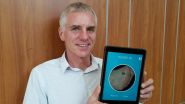The Arctic: Interglacial period with a break
Reconstruction of Arctic climate conditions in the Cretaceous period
2015-05-28
(Press-News.org) This news release is available in German.
FRANKFURT. Scientists at the Goethe University Frankfurt and at the Senckenberg Biodiversity and Climate Research Centre working together with their Canadian counterparts, have reconstructed the climatic development of the Arctic Ocean during the Cretaceous period, 145 to 66 million years ago. The research team comes to the conclusion that there was a severe cold snap during the geological age known for its extreme greenhouse climate. The study published in the professional journal Geology is also intended to help improve prognoses of future climate and environmental development and the assessment of human influence on climate change.
The Cretaceous, which occurred approximately 145 million to 66 million years ago, was one of the warmest periods in the history of the earth. The poles were devoid of ice and average temperatures of up to 35 degrees Celsius prevailed in the oceans. "A typical greenhouse climate; some even refer to it as a 'super greenhouse' ", explains Professor Dr. Jens Herrle of the Goethe University and Senckenberg Biodiversity and Climate Research Centre, and adds: "We have now found indications in the Arctic that this warm era 112 to 118 million years ago was interrupted for a period of about 6 million years."
In cooperation with his Canadian colleague Professor Claudia Schröder-Adams of the Carleton University in Ottawa, the Frankfurt palaeontologist sampled the Arctic Fjord Glacier and the Lost Hammer diapir locality on Axel Heiberg Island in 5 to 10 metre intervals. "In so doing, we also found so-called glendonites", Herrle recounts. Glendonite refers to star-shaped calcite minerals, which have taken on the crystal shape of the mineral ikaite. "These so-called pseudomorphs from calcite to ikaite are formed because ikaite is stable only below 8 degrees Celsius and metamorphoses into calcite at warmer temperatures", explains Herrle and adds: "Thus, our sedimentological analyses and age dating provide a concrete indication for the environmental conditions in the cretaceous Arctic and substantiate the assumption that there was an extended interruption of the interglacial period in the Arctic Ocean at that time."
In two research expeditions to the Arctic undertaken in 2011 and 2014, Herrle brought 1700 rock samples back to Frankfurt, where he and his working group analysed them using geochemical and paleontological methods. But can the Cretaceous rocks from the polar region also help to get a better understanding of the current climate change? "Yes", Herrle thinks, elaborating: "The polar regions are particularly sensitive to global climatic fluctuations. Looking into the geological past allows us to gain fundamental knowledge regarding the dynamics of climate change and oceanic circulation under extreme greenhouse conditions. To be capable of better assessing the current man-made climate change, we must, for example, understand what processes in an extreme greenhouse climate contribute significantly to climate change." In the case of the Cretaceous cold snap, Herrle assumes that due to the opening of the Atlantic in conjunction with changes in oceanic circulation and marine productivity, more carbon was incorporated into the sediments. This resulted in a decrease in the carbon dioxide content in the atmosphere, which in turn produced global cooling.
The Frankfurt scientist's newly acquired data from the Cretaceous period will now be correlated with results for this era derived from the Atlantic, "in order to achieve a more accurate stratigraphic classification of the Cretaceous period and to better understand the interrelationships between the polar regions and the subtropics", is the outlook Herrle provides.
INFORMATION:
Publication
Jens O. Herrle, Claudia J., Schröder-Adams, William Davis, Adam T. Pugh, Jennifer M. Galloway, and Jared Fath: Mid-Cretaceous High Arctic stratigraphy, climate, and Oceanic Anoxic Events, in: Geology, 19 Mai 2015, 10.1130/G36439.1 Open Access
http://geology.gsapubs.org/cgi/content/abstract/G36439.1v1
Pictures are available for download here: http://www.senckenberg.de/presse
Information: Prof. Dr. Jens O. Herrle, Senckenberg Biodiversity and Climate Research Centre, Faculty of Geoscience and Geography, Goethe University Frankfurt, Phone +49 (0)69 798 40180, jens.herrle@em.uni-frankfurt.de
Goethe University is a research-oriented university in the European financial centre Frankfurt founded in 1914 with purely private funds by liberally-oriented Frankfurt citizens. It is dedicated to research and education under the motto "Science for Society" and to this day continues to function as a "citizens' university". Many of the early benefactors were Jewish. Over the past 100 years, Goethe University has done pioneering work in the social and sociological sciences, chemistry, quantum physics, brain research and labour law. It gained a unique level of autonomy on 1 January 2008 by returning to its historic roots as a privately funded university. Today, it is among the top ten in external funding and among the top three largest universities in Germany, with three clusters of excellence in medicine, life sciences and the humanities.
Publisher: The President of Goethe University Frankfurt
Editor: Dr. Anke Sauter, Science Editor, International Communication, Phone +49(0)69 798-12498, Fax +49(0)69 798-761 12531, sauter@pvw.uni-frankfurt.de
Internet: http://www.uni-frankfurt.de
ELSE PRESS RELEASES FROM THIS DATE:
2015-05-28
(Edmonton) Each year, thousands of Canadians are given the news: they have skin cancer. It is the most common form of cancer in Canada and around the world, but if detected early, survival rates are extremely high. According to Liam Rourke, it doesn't happen nearly as often as it could.
"The difficulty is that people have a really hard time detecting skin cancer melanomas early," says Rourke, an associate professor in the Faculty of Medicine & Dentistry's Department of Medicine at the University of Alberta. "One of the reasons is that it's an exceptionally difficult task ...
2015-05-28
Investigators at Stanford University have found a surprising link between creative problem-solving and heightened activity in the cerebellum, a structure located in the back of the brain and more typically thought of as the body's movement-coordination center.
In designing the study, the researchers drew inspiration from the game Pictionary.
The cerebellum, traditionally viewed as the brain's practice-makes-perfect, movement-control center, hasn't been previously recognized as critical to creativity. The new study, a collaboration between the School of Medicine and ...
2015-05-28
Stanford electrical engineer Jelena Vuckovic wants to make computers faster and more efficient by reinventing how they send data back and forth between chips, where the work is done.
In computers today, data is pushed through wires as a stream of electrons. That takes a lot of power, which helps explain why laptops get so warm.
"Several years ago, my colleague David Miller carefully analyzed power consumption in computers, and the results were striking," said Vuckovic, referring to electrical engineering Professor David Miller. "Up to 80 percent of the microprocessor ...
2015-05-28
A quantum system never relaxes. An isolated system (like a cloud of cold atoms trapped in optical grids) will endlessly oscillate between its different configurations without ever finding peace. In practice, these types of systems are unable to dissipate energy in any form. This is the exact opposite of what happens in classical physics, where the tendency to reach a state of equilibrium is such a fundamental drive that is has been made a fundamental law of physics, i.e., the second law of thermodynamics, which introduces the concept of entropy.
This profound difference ...
2015-05-28
WASHINGTON -- People who earn a college degree before getting married are much less likely to become obese than those who graduate from college after getting married, according to a new study.
"People who get married before they earn a degree from a four-year college are about 65 percent more likely to later become obese than people who get married after college," said Richard Allen Miech, a research professor at the Institute for Social Research at the University of Michigan and the lead author of the study. "While a college degree has long been shown to be associated ...
2015-05-28
A fifty-fold between-country difference in rates of paracetamol-induced acute liver failure that leads to liver transplant (ALFT) has been revealed by a study that compared patient data from seven countries at the request of the European Medicines Agency: France, Greece, Ireland, Italy, Netherlands, Portugal and the UK. Researchers discovered that this variation was even more pronounced on a per-capita basis, with a 200-fold difference in ALFT cases. Publishing these findings in the British Journal of Clinical Pharmacology, the authors call for further research to identify ...
2015-05-28
Several genes have been lost from the Y chromosome in humans and other mammals, according to research published in the open access journal Genome Biology. The study shows that essential Y genes are rescued by relocating to other chromosomes, and it identifies a potentially important genetic factor in male infertility.
The Y chromosome is dramatically smaller than the X chromosome and has already lost nearly all of the 640 genes it once shared with the X chromosome.
An extreme example of genes disappearing from the Y chromosome can be found in the Ryukyu spiny rat, ...
2015-05-28
In what they believe to be the first survey of its kind in the United States, researchers at NYU Langone Medical Center have found that as many as 6 percent of adult New Yorkers who get "inked" -- in other words, those who get a tattoo -- have experienced some form of tattoo-related rash, severe itching or swelling that lasted longer than four months and, in some cases, for many years.
"We were rather alarmed at the high rate of reported chronic complications tied to getting a tattoo," says senior study investigator and NYU Langone dermatologist Marie Leger, MD, PhD, ...
2015-05-28
Researchers from the Netherlands have explored how 3D printing can be used to help treat type 1 diabetes in results presented today, Thursday 28 May, in IOP Publishing's journal Biofabrication.
The 3D printing technique, known as bioplotting, has taken researchers one step closer to being able to help patients who experience severe hypoglycaemic events, commonly known as 'hypos'- a problem that affects about a third of people with type 1 diabetes according to Diabetes UK.
The paper describes how clusters of specialized cells responsible for the production of insulin ...
2015-05-28
This news release is available in French. Alzheimer's disease is the most common form of dementia, affecting over 44 million people worldwide. Inside the brain, Alzheimer's disease is characterized by loss of neurons, and presence of abnormal tangles and plaques in the brain. Dr. Graham Collingridge, recently recruited from Bristol (U.K.) to the University of Toronto, has found that molecules that are strongly associated with Alzheimer's disease are important players in a process called long-term depression (LTD). LTD is a process through which the strength of synapses, ...
LAST 30 PRESS RELEASES:
[Press-News.org] The Arctic: Interglacial period with a break
Reconstruction of Arctic climate conditions in the Cretaceous period

